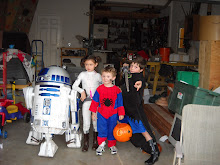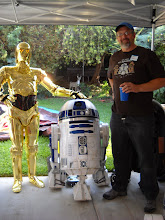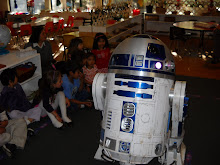I snatched a bit of time today to do some work. Almost all of the my supplies have arrived now. On the Senna design, the wheel is fixed to the axle and the gears are fixed to the axle to drive the wheel. So the connection between the axle and the frame needs to tolerate some metal on metal friction or have a bearing or something. I have these two options:
Those are bearings on the left with a .5" inside bore and an outside diameter of 1.25" or so (Can't remember.) I picked them up at a local surplus yard (Blue Collar Supply) for $.50 each. On the right are some impregnated bushings from McMaster-Carr. I think these are the same ones Mike Senna recommends. The inside bore is .5" and the outside diameter is .75" I think I'd prefer to have the axles riding in a bearing that could turn. But I decided that I would start with the smaller ones. That way I can bore out the frame plates to fit, and if I don't like them, I can go bigger to the bearings. Plus, I don't have an effective way to cut/drill an accurate hole for the bearings to mount in.
So I set up a jig on my drill press that would let me drill all eight holes in the side plates as accurately and consistently as possible. It's important to get the holes aligned across the frames exactly right, or the wheels will sit crooked and not track right. Earlier, after I rough cut all the trapezoidal side plates, I clamped them all together and sanded all the edges on the belt sander. That got all four side clean, and it got the size off all of them as close as I could get them. That helps for cuts and drilling later. It's always worth it when you're creating multiple pieces of something to set up a jig or fence or some other method to make all the cuts as uniform as possible. That makes fitting and every step thereafter much easier and it will produce more accurate results. Here's the jig on the drill press. Just a couple of blocks clamped down to hold the plates in exactly the right place:
I'm using the step drill bit here because it's so effective at drilling these larger holes. This way, the steps each just have to take out 1/8" of material or so at a time instead of cutting the hole thing at once. I just discovered these recently and I use them all the time now. Don't buy one of the outrageously expensive ones at a tool store--$50-$75!! Harbor Freight has always got some for a few bucks. Get a couple and when it wears out, throw it out.
Drilling here gave me some trouble. The bit was binding and heating up when I got down deep. I have heard people say that you need to lubricate metal when you are cutting it so that the blade or bit slides. It reduces friction, and the cutting edge does all the work. I was skeptical about this, but I tried it here on the bit and it worked great. The bit just slide right through these pieces once I had a good shot of WD-40 on the bit and the piece. And it didn't catch on fire, like I thought it would. Valuable lesson about working with metal.
That gave me some clean, uniform holes. I think they were no more than a millimeter off across the different pieces so the jig worked pretty well:
A bit more grinding on the inside of these holes with the dremel tool, and they were ready to take the bushings for the axles.
In order to get the fat wheels into the frames, it looks like I am going to have to assemble the side plates on the outside of the lip on the top channel.
I'll have to countersink the holes so those bolt heads sit down flush. But you can see it come together here. That'll be a quick fix when I get some more time. And I'll need to cut a slot down the top of the top plate to receive the threaded rods coming down from the legs. More on that later.
Next I rough cut a couple of six inch pieces of axle. That should be enough to accommodate the gears, the bushings, and the axle collars. There's a bit of loose space inside between the wheels and the bushings here. But I think a single .5" washer on either side of the wheel will be just right.
Next up, I'll get the gears and motor brackets all figured out and start assembling the rest of the pieces. The plan is to make this a four wheel drive system. So the motors will drive one wheel, and then that wheel will drive the other wheel with a gear and chain. Check the pictures of his system in the Yahoo Group for comparison. More soon.
Tuesday, January 26, 2010
Subscribe to:
Post Comments (Atom)












No comments:
Post a Comment